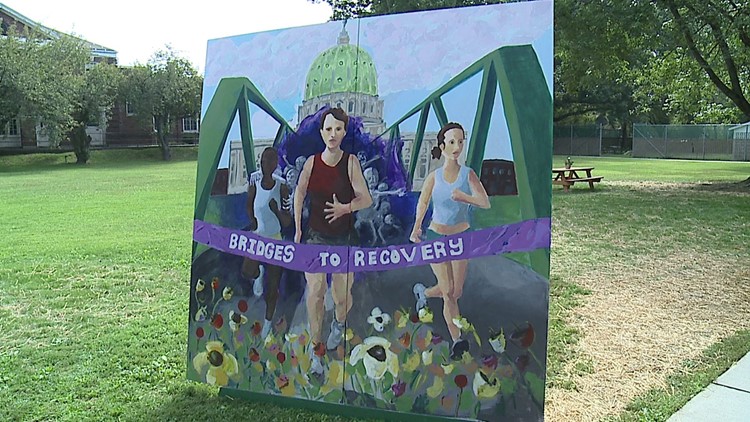Harrisburg, Pa. –Experts are trying to figure out how to stop people from dying from the drug overdose crisis in Pennsylvania.
At an event Monday, officials highlighted international overdose day and also kicked off drug and alcohol recovery month. The Department of Drug and Alcohol Programs and the Department of Health held the event at Gaudenzia Concept 90 to raise awareness of the drug overdose crisis in Pennsylvania and focus on recovery through the Building Bridges to Recovery initiative.
“I’ve been in healthcare for 30 years and can say it is the worst public health crisis we have ever seen,” said Dr. Karen Murphy, Department of Health Secretary.
A mural, painted by individuals in recovery at Gaudenzia, was unveiled at the event representing Building Bridges to Recovery initiative to commemorate September as Recovery Month in Pennsylvania.
“There are many paths to recovery, there is not just one. Like me, I started in prison and came here. Others come off of the streets, it’s different for everybody,” said a person in recovery, who helped designed the mural. To him, it symbolizes an addicts struggle to get clean. His story is all too familiar. By 19, he’d been homeless, addicted to painkillers, and in jail. Now in recovery, he hopes the work of art and his message will help inspire others. ‘Recovery has helped me to identify behaviors that I wasn’t able to in the past,” he said.
In front of a crowd of people, another recovering addict shared his story of addiction, and a time when he overdosed and almost died. He was revived after someone administered the life-saving drug Naloxone. He has been clean since 2013 and now helps others in recovery. He said more funding for treatment is long overdue. “If we want people to stop dying at alarming rates it’s time to put the funds necessary in that direction.”
Overdoses [from Departments of Drug & Alcohol Programs and Health]
The Wolf Administration announced Monday that 289 drug overdoses have been reversed statewide since Pennsylvania State Police and local police departments have begun carrying the life-saving drug kits, naloxone. Heroin and opioid overdose are the leading cause of accidental death in Pennsylvania, killing more individuals than those involved in fatal motor vehicle accidents. In 2013, approximately 2,400 Pennsylvanians died from a drug overdose.
“Pennsylvania has been seeing a sharp increase in drug overdoses across the state. Having naloxone kits in the hands of our first responders who are often first on the scene, can make the difference between life and death,” Department of Drug and Alcohol Programs Secretary Gary Tennis said. “In less than a year since David’s law was implemented, we are thrilled with the number of lives saved; these hailed as heroes in their communities, and deservedly so.”
“Sadly we have seen the deadly consequences of drug addiction,” said Secretary of the Department of Health (DOH) Dr. Karen Murphy. “We applaud the heroic work of first responders who have acted with professionalism to save the lives of so many Pennsylvanians.”
Earlier this year, Governor Wolf announced that Pennsylvania State Police would carry naloxone providing statewide coverage. Shortly after, DDAP and DOH announced naloxone grants, administered by the Pennsylvania District Attorneys Association and the Pennsylvania Association of County Drug and Alcohol Administrators. These grants provided funding to supply two naloxone kits in every state police car across the state, as any local police department that applies. All the funding was generously donated by several insurance providers across the state. The Physician General signed a standing order giving law enforcement officers and firefighters the ability to access naloxone. David’s Law, also known as Act 139, enables first responders (law enforcement, fire fighters and all EMS) to administer naloxone to individuals experiencing an opioid overdose.
Friends or family members with a loved one at risk of experiencing an opioid related overdose now can also obtain a prescription from their doctor for naloxone and administer it. If statutory requirements are met, the law also provides Good Samaritan and other immunity protections from criminal prosecution for drug possession as well as from civil liability for those responding to and reporting an opioid overdose.
Naloxone, also known by the brand name “Narcan” is a prescription life-saving medicine that rapidly reverses heroin and other opioid overdoses. Heroin and opioid overdose are the leading cause of accidental death in Pennsylvania, killing more individuals than those involved in fatal motor vehicle accidents. In 2013, approximately 2,400 Pennsylvanians died from a drug overdose.
Commonly used opioids include Heroin, Oxycontin, Fentanyl, Morphine, Vicodin and Percocet. For more information on overdose and naloxone, visit www.ddap.pa.gov.



